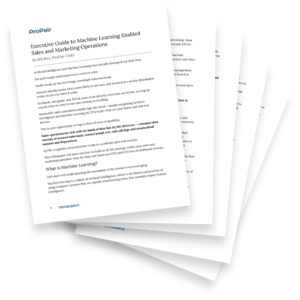What's in this article?
Sales automations are often thought of as ways to cut corners and focus only on efficiency. But it’s more sophisticated than that.
Sales automation tools optimize your entire sales operations so that sales teams have a clear focused path to sell to leads.
With these essential sales automations for sales operations, you’ll learn how each helps to ensure you’re collecting the right lead data, managing it cleanly, reporting on it for quality insights, and ensuring qualified leads and informed salespeople move through the sales process consistently.
First, let’s start with what is sales automation.
What is sales automation?
Sales automation involves taking tasks that are otherwise repetitive, manual, and time-consuming for sales teams and making them more efficient and automatic through tools including CRM systems, AI/ML tools, and other software.
By automating these tasks, sales teams don’t have to manually manage them on a daily basis. And in most cases through automation, sales operations gain more data that they are better informed on how to act on than would be possible through manual management.
Sales automation software allows for optimized lead management, increased performance and productivity, better data accuracy, and overall improved quality of the sales process for both salespeople and consumers.
Learn more: How to Use AI for Automated Lead Management Solutions.
12 essential sales automations for sales operations success in 2022
Let’s dig into the essential sales automations for 2022 that create success for sales operations teams, from lead management to data entry, lead communication, and data management.
1. Lead scoring
Assigning certain values to leads is a way of making it simple to understand their behavior and demographics.
Automating how these scores get assigned is easy with artificial intelligence and machine learning tools like ProPair’s RANK where lead behaviors are tracked and quantified. This data can then be used to predict outcomes for each lead, helping sales teams understand which leads are most qualified.
Check out The Ultimate Guide to Optimizing Lead Scoring and Growing Business
2. Lead distribution
After each lead is generated it needs to be assigned to a salesperson. This in the past required sales operations to manually set rules and come up with ways to fairly and effectively distribute leads.
With sales automation tools like ProPair’s MATCH, AI/ML help to analyze and predict which salespeople will be most likely to successfully work each lead. They’re then automatically assigned leads as they come in and the analysis happens automatically and instantly.
Want to know more? Read our Guide to Lead Distribution: Getting the Right Leads to the Right Sales Agents
3. Lead prioritization
Beyond knowing what leads are qualified and which salespeople should work with them, each salesperson needs to know how to prioritize their interactions and the paths they’ll take with each lead.
ProPair’s MIX tool works within your CRM sales automations to allow for optimizing both aspects of managing leads and salespeople so that it’s clear which leads are most qualified and, therefore, most likely to be ready to make a purchase.
Prioritizing leads based on intelligent predictions is a competitive advantage that sales operations are increasingly using to optimize their lead management.
Read more: Simple Guide to Optimizing AI/ML for Business Operations
4. Record creation
Keeping up with lead and customer records can be a pain and a mess without CRM sales automations. With automation tools, when a lead or customer engages or provides more information, that data can automatically be added to their record.
Record maintenance can also be automated, cleaning up lead and customer records to avoid duplicates and outdated contact information, for example.
5. Activity logging
Rather than having each salesperson manually track their activities, automating parts of their daily work allows for automated collection and tracking of activity based on certain triggers.
Activity can be logged and then used for reporting, analysis, etc. without being a constant nuisance to sales teams that should instead focus on doing their daily tasks, rather than having to also worry about logging them.
6. Data entry
Most scenarios where you need to enter information, either about leads or when in communication with leads, can be automated to take the repetition out of these tasks and instead make them more efficient, cleaner, and simpler.
Automated data entry ensures that records are kept more streamlined, which can make things easier to track.
7. Emails
This includes creating automated email sequences that come from individual salespeople as well as broader marketing emails. Both keep prospects engaged and can be set up based on various triggers that would make it appropriate to send a follow-up email, confirmation, or further information.
These keep salespeople and marketing teams from repeatedly managing email sequences and campaigns that consistently need to be sent to prospective customers. Beyond sending emails, triggers can also intelligently predict and plan the best timing to send emails you’ve created, based on various lead behaviors.
8. Voicemails
Like emails, voicemails can be packaged and reused repeatedly to avoid having to say the same things over and over when leads don’t answer the phone. Instead, pre-recorded voicemails can be dropped into leads’ inboxes.
This can be automated further with auto-dialers that call leads and leave ringless voicemails as leads come in or trigger certain actions, meaning the salesperson can basically set it and forget it rather than make a phone call each time.
9. Scheduling
Automated emails and voicemails help to keep things moving to get leads to schedule your first conversation or to have prospects schedule ongoing conversations.
With scheduling sales automations, salespeople don’t have to manually check their calendars every time they want to speak with a lead. They can set available times and provide those universally to leads so that each lead can choose their own time. From there a meeting is automatically scheduled.
10. Guidance
Automated guidance notifies and informs salespeople about what they should do next.
Within a CRM system or other sales automation software, sales teams can be reminded about what actions to take to keep moving toward a sale. These can be set so that when a salesperson takes a certain action, it triggers an alert that tells them what’s next.
This streamlines common steps so the entire team is on the same page and no steps are missed.
Get our free download to learn the top 5 ways to boost sales with AI.
11. Reporting
Manual reporting can take hours of time away from salespeople on a regular basis. Instead, reporting parameters can be set up initially, which also ensures the right data is being tracked and collected to support the necessary reporting.
From there, reports can be automatically generated when needed or on a set cycle.
12. Forecasting
Like reporting, most data analysis is better when automated. Forecasting is an important one, as it saves time from guessing at relevant data and trends.
Instead, it allows sales teams to consistently set and see automated forecasting data with the most up-to-date insights rather than manually sort through various data sets, spreadsheets, records, etc. and try to make sense of them.
Get a competitive advantage with sales automation tools
These sales automations sound useful right? But some sales operations teams don’t think they’re ready to implement sales automation software and probably don’t realize how much they’re missing out on by dragging their feet.
With decision support systems like ProPair, not only are automations easy to optimize but they’re also backed by machine learning that predicts outcomes through data analysis that would not be possible manually.
For ProPair’s RANK, MATCH, and MIX tools, we add one simple production-ready integration to your system. It runs in the background as leads come into your CRM and provides you with automatic insights and optimized lead management ROI.
Are you missing out on sales because your lead management and sales automations need improvement?
See for yourself. Schedule a free ProPair demo.
We use machine learning to analyze your current leads and their performance to help you see where you’re missing opportunities. From there we’ll help you make improvements to optimize predictive sales automation.

How does AI increase sales?
Download our executive guide to understand the current state of AI and machine learning. We’ll show you how innovative sales and marketing organizations use it to get ahead of their competition.



